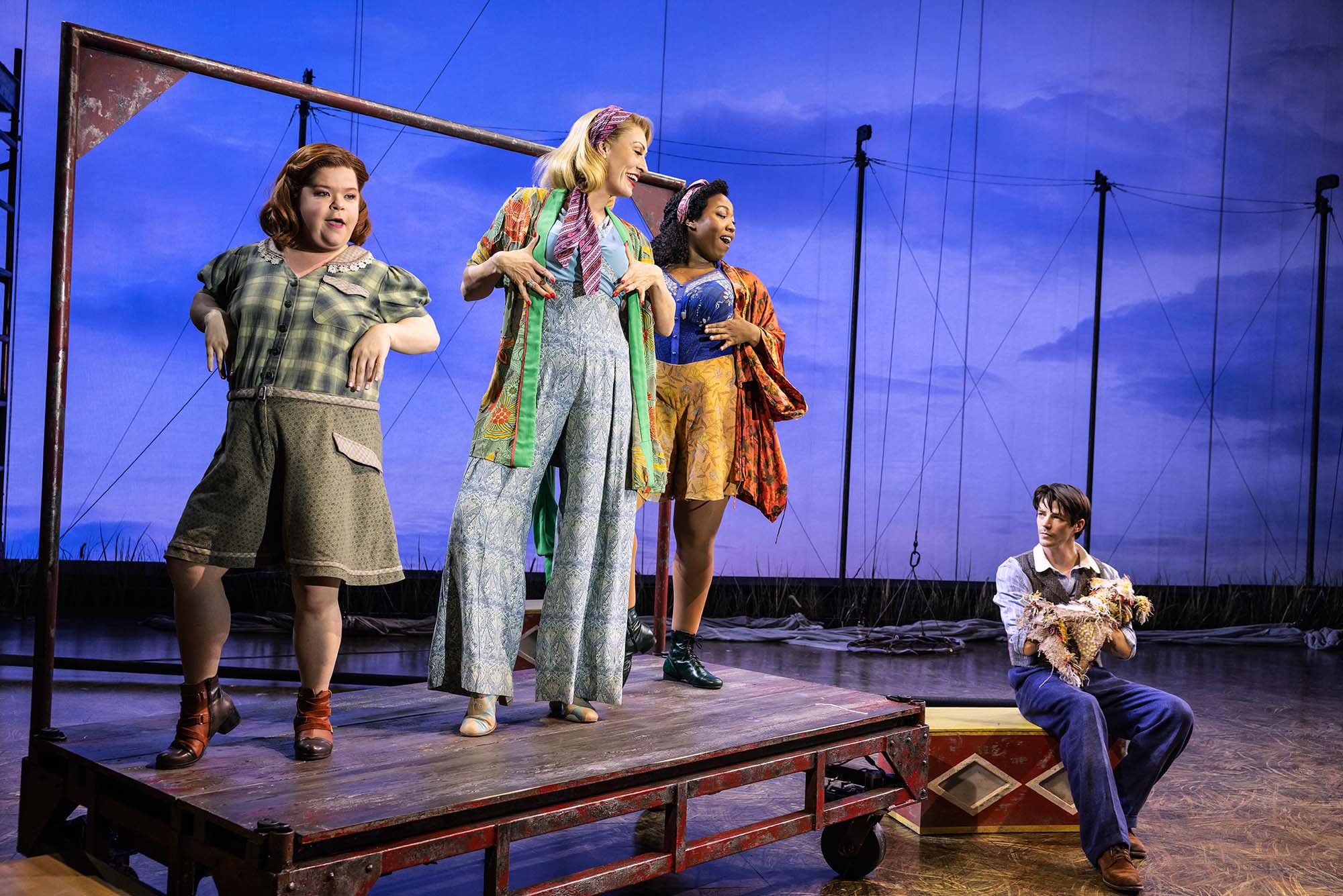His First Broadway Show Just Earned This CFA Alum a Tony Award Nod
David Israel Reynoso nominated for best costume design for a musical for Water for Elephants

David Israel Reynoso designed nearly 100 costumes for Water for Elephants. Photo by Matthew Murphy
His First Broadway Show Just Earned This CFA Alum a Tony Award Nod
David Israel Reynoso nominated for best costume design for a musical for Water for Elephants
For many, earning a Tony Award nomination—American theater’s biggest prize—is the culmination of decades of work on Broadway. Not so for David Israel Reynoso. He’s received a 2024 Tony nod for Best Costume Design of a Musical for his first Broadway show, Water for Elephants.
A theater junkie from middle school on, Reynoso grew up watching the annual Tony Awards ceremony (this year’s is Sunday, June 16, and will be broadcast on CBS starting at 8 pm). He says he burst into tears when he learned he’d been nominated.
“I never imagined that I’d be at the Tony Awards, never mind be one of the people who’s up for an award,” says Reynoso (CFA’03), who has also been nominated for a 2024 Drama Desk Award for his Water for Elephants costumes. “It would be amazing to feel that my work has merit. Being among my fellow nominees, who are all people I look up to, just feels incredible. I know it sounds so cliché, but I already feel that just being nominated is enough.”
Water for Elephants is a theatrical adaptation of Sara Gruen’s 2006 best-selling novel about a young man who joins a traveling circus during the Depression. The New York Times hailed the show as a “stunning, emotional production.” While the musical marks Reynoso’s Broadway debut, he’s been plying his craft as both a costume and scenic designer at regional theaters for nearly two decades, including the American Repertory Theater, Seattle Repertory Theatre, Arena Stage, La Jolla Playhouse, and The Old Globe in San Diego, where he’s based.
Water for Elephants
Reynoso credits Water for Elephants director Jessica Stone with helping him land his inaugural Broadway show. The two had worked together on several productions at The Old Globe, including revivals of George Bernard Shaw’s Arms and the Man and Neil Simon’s Barefoot in the Park. They clicked immediately.
“We have similar sensibilities, we love aesthetics and color and the use of color,” Reynoso says. Stone, who was nominated for a Tony last year for her direction of the musical Kimberly Akimbo, approached Reynoso about designing the costumes for Water for Elephants in 2018, during the show’s early planning stages. He flew to New York to meet with the producers and got their approval.



Scenes from Water for Elephants, nominated for seven Tony Awards, including best costume design of a musical, for Reynoso. Photos by Matthew Murphy
To create the show’s nearly 100 costumes, Reynoso looked at black-and-white or sepia photographs from the 1930s, as well as colorful circus posters, for inspiration. It was difficult to discern the color and interesting patterns of the clothing in the photographs, but the posters were bursting with color. Reynoso was also inspired by the period—the height of the Depression—a time when people were forced to make outfits out of remnants, mixing fabrics. “I wanted that visually rich aspect to that kind of collage, which I was quite drawn to,” he says.
The musical, nominated for seven Tonys, presented other challenges. The actors are constantly moving back and forth in time, from the 1930s to the 1990s, often without leaving the stage. And, because the musical is set against the backdrop of a traveling circus, many of the actors perform complicated acrobatics, so costumes had to be durable.
In the video above, see a montage of scenes from Water for Elephants. Video courtesy of Polk and Company
A pre-Broadway run last year at the Alliance Theatre in Atlanta proved invaluable for the show’s designers as they figured out what worked—and what didn’t. “There was so much that we learned from that experience in terms of which costumes experienced the most wear and tear and what adornment was going to last, so that when we got to Broadway, we weren’t taking guesses,” Reynoso says. “We had an informed guess on what fabrics would be the best ones in terms of what the performers needed to do.”
The team of designers set about creating a visual through line for the show that would resemble a vintage postcard.
“When you think of a really beautiful postcard, it’s the full composition, right?” he says. “When I saw what the set was doing and then what the projections were doing and the lighting, then thinking, well, what are the beautiful color tones someone might be wearing that would actually sing against that backdrop? It just felt like we were all paying attention to each other and in communication with each other.”

A fascination with creating three-dimensional art
Growing up in Guadalajara, Mexico, Reynoso loved to draw and conjure worlds that people could immerse themselves in. He recalls rearranging the furniture in his bedroom to stage installations that his family could walk through. His dream was to work as an “imagineer” for Disney theme parks.
When Reynoso was 12, he and his family moved to Texas. He found it difficult to adjust to life in a new country, but salvation came in the form of theater. He began acting in local plays. By high school, he was designing sets for plays and planning to study scenic design at a college in Texas. After winning a scholarship and grant from Boston University, he decided to head north. “I said to myself at the time, I can always come back if this doesn’t go well,” he says.
Reynoso majored in scenic design at the College of Fine Arts, but during one School of Theatre production, he had a chance to work on costumes—and was mesmerized. At the time, Denise Wallace-Spriggs (CFA’16) was a School of Theatre lecturer and the resident crafts artisan/dyer for the Huntington Theatre Company. She was designing costumes for a production of Spring Awakening, he says, and taught him to create “these enormous, grotesque puppet heads,” that the faculty in the show wore.
“I found myself fascinated by the idea of getting to create something three-dimensional, that’s a wearable thing,” Reynoso says, adding that his understanding of the importance of costumes in conveying a character to an audience has changed over the decades. “Initially, I assumed costumes were just ornamental, but I came to understand that they help to tell a story about who a person is. I love the idea that clothing communicates so much about a person.”
After a brief stint in New York following graduation, he returned to Boston, where he landed a temporary job in the American Repertory Theater’s props department. He made an impression and was offered a position as a craft artisan in its costume department. Shortly after, he was selected to create a dress for a one-woman show at A.R.T., which led to more jobs with the company, as both a costume and a scenic designer.

His big break came when Punchdrunk Theatre, the London-based company known for creating groundbreaking immersive theater, brought their production of Sleep No More to the A.R.T. Reynoso was asked to design the costumes for the show, a nonverbal retelling of Shakespeare’s Macbeth, featuring movement, dance, and dazzling visuals. The show transferred to New York, and Reynoso won an Obie Award for his work.
“It tapped into that thing I felt as a kid,” he says, “when I really wanted to be part of creating worlds that one could get lost in and feel like they are visiting for a brief moment.”
After that, he did something somewhat radical for an up-and-coming theater designer: he decamped to the West Coast—to San Diego, where he had no theater connections.
He started making cold calls to local theaters, including the venerable La Jolla Playhouse and The Old Globe. Soon he was designing costumes for dozens of shows, including musicals (Hair, In the Heights), Shakespeare (A Midsummer Night’s Dream, As You Like It), and period dramas (Time and the Conways, Ghosts).
Designer, director, playwright



Scenes from Optika Moderna productions of Waking La Llorona (left), Las Quinceañeras (center), and La Teatro Piñata, immersive theater experiences where audiences move through rooms, interacting with actors. “I wanted to be part of creating worlds that one could get lost in,” Reynoso says. La Llorona photo by Santiago Iacinti; Las Quinceañeras and La Teatro Piñata photos by Emily Schmit.
In 2017, Reynoso launched his own design company, Optika Moderna, with a goal of creating lushly produced immersive theatrical experiences, many inspired by his Mexican heritage. The result: a series of acclaimed groundbreaking shows that seek to transport audiences into new realms, “challenge perceptions, and leave lasting impressions.”
Each Optika show begins with theatergoers entering a magical optician’s office, where they are outfitted with headsets that act as a kind of camera, focusing each person’s attention on what’s in front of them.

The first Optika production, Waking La Llorona, was inspired by a famous character in Latin American folklore—La Llorona—who descends into madness and drowns her children. She is then left to wander the earth in mourning. The most recent show, La Lucha, explores the Mexican sport of masked wrestling, with audiences moving through a series of corridors, rooms, and wrestling rings, where they interact with silent masked actors.
“We say that our mission is to create a bold experience that peers through the eyes of another—so, the idea is that you are invited to take a peek at things through a new lens,” Reynoso says. “The idea is to be able to leave behind reality and embark into a new one… You’re able to experience a story that leaves a greater impression on you, because you’re able to let go of your preconceived notions of it.”
Reynoso’s next two projects are an ambitious production of Shakespeare’s six Henry plays, staged in two parts, for The Old Globe this summer, and the set and costume design for a production of Swan Lake for Ballet West.
The 2024 Tony nomination has given him a new level of visibility. But he’s trying to be selective about the projects he accepts—especially those that take him away from home (he has two children, ages six and nine). “It’s hard for me to say no to a project, but I’m working on that,” he says.
The most pressing issue at the moment: what to wear to the Tony Awards Sunday night.
“That’s what’s stressing me out the most,” Reynoso confides. “People are like, ‘You’re a costume designer, you’re going to have something amazing.’ Wish me luck. I need to find something great to wear.”
Other BU alums nominated for a 2024 Tony Award are producers Bonnie Feld (CAS’73), best musical for Water for Elephants, Sue Wagner (CFA’97), best play for Stereophonic, James Nederlander (CGS’80), best musical for Hell’s Kitchen and The Outsiders and Corey Steinfast (COM’16), best play revival for Appropriate.
The 77th annual Tony Awards ceremony will be broadcast live on CBS from the David H. Koch Theater at Lincoln Center for the Performing Arts on Sunday, June 16, at 8 pm EDT and will also stream live and on-demand on Paramount+. The Tony Awards: Act One, a preshow of live exclusive content, including the evening’s first presentation of awards, streams exclusively on Paramount+ and Pluto TV, a free-to-use streaming service, starting at 7 pm EDT.

Comments & Discussion
Boston University moderates comments to facilitate an informed, substantive, civil conversation. Abusive, profane, self-promotional, misleading, incoherent or off-topic comments will be rejected. Moderators are staffed during regular business hours (EST) and can only accept comments written in English. Statistics or facts must include a citation or a link to the citation.